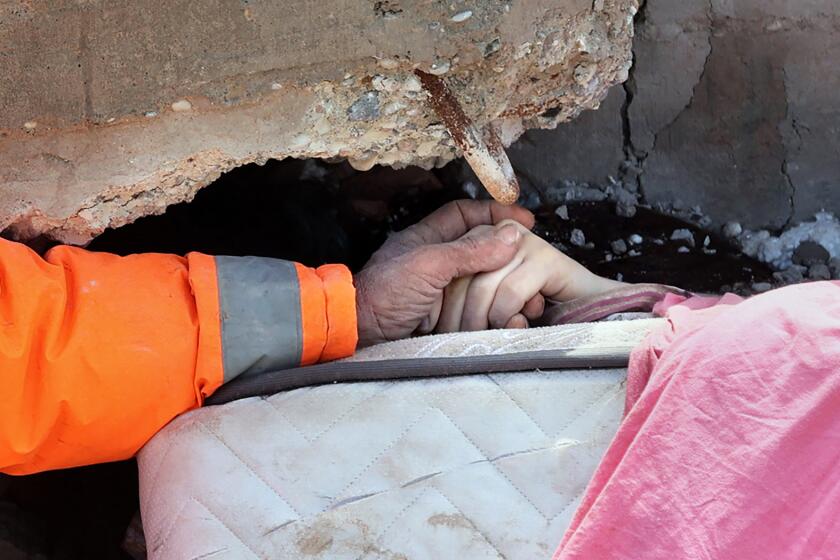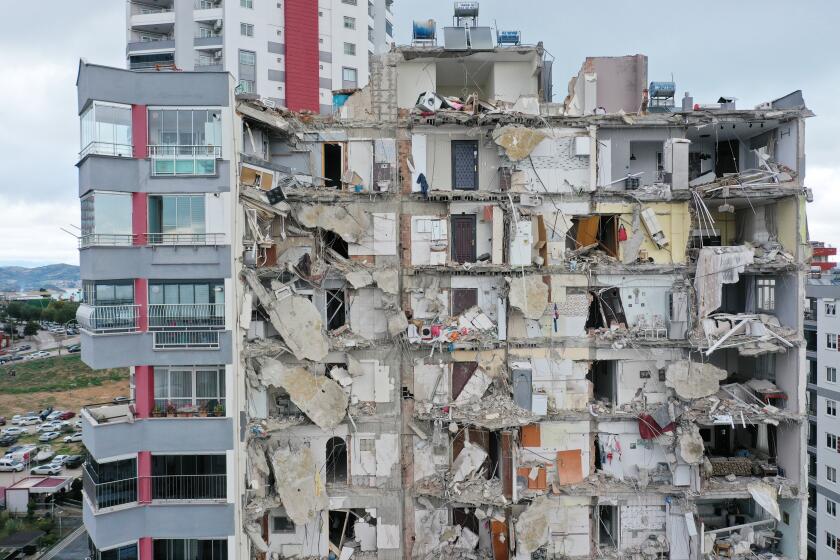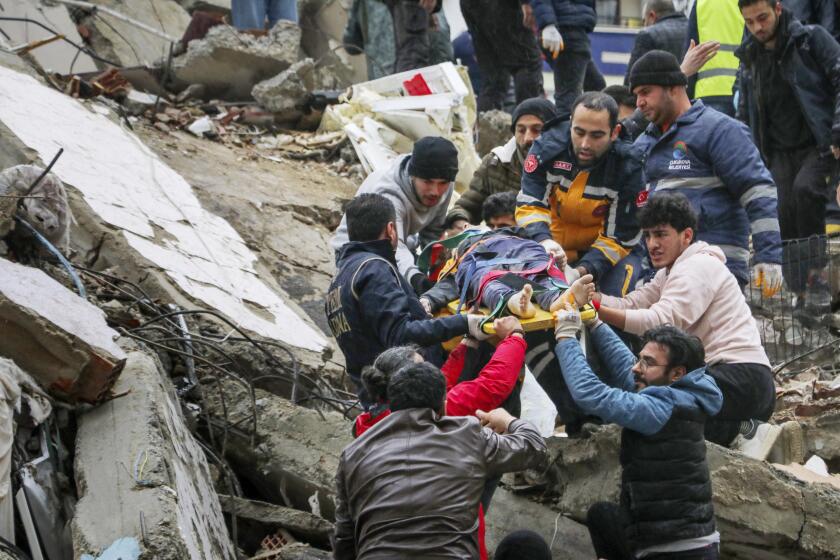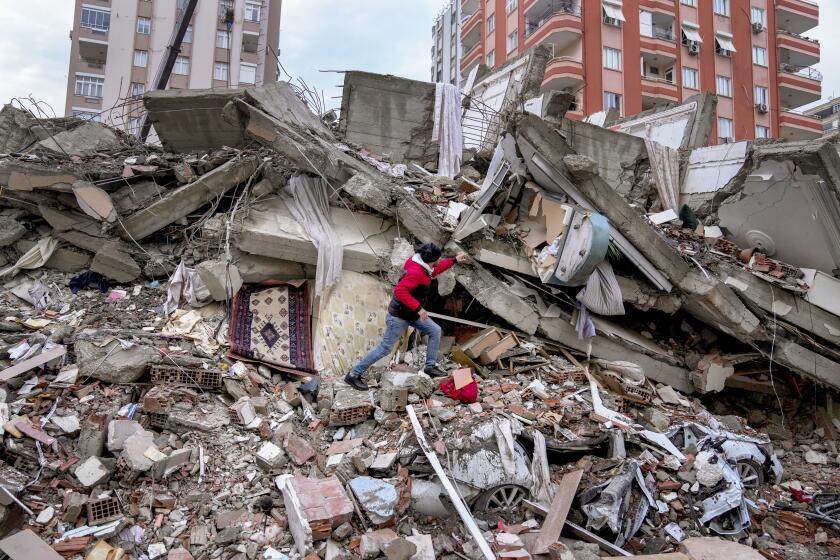California hasn’t seen a catastrophic earthquake recently. But ‘quiet’ period won’t last

- Share via
This week’s catastrophic earthquake in Turkey and Syria is just the latest warning of the potential risks for California and other seismically active areas.
Some California cities have retrofitted or demolished problem buildings following quakes in the 1980s and 1990s. But many buildings in the state have not endured the same kind of intense shaking experienced in Turkey and Syria.
The death toll is in the thousands after a magnitude 7.8 earthquake, followed by a magnitude 7.5 quake, struck southern Turkey.
The magnitude 7.8 earthquake struck southeastern Turkey at 4:17 a.m. local time Monday on the East Anatolian fault. Aftershocks have rippled throughout the southeast part of the country and Syria. A powerful magnitude 7.5 aftershock on a different fault struck nine hours later, with an epicenter 60 miles to the northeast, producing another round of devastation.
The San Andreas fault is capable of similar activity.
“We’ve had 7.8 earthquakes in our historic past. We’ve had a great run without them, but it’s important to be prepared for these possibilities in the future,” said U.S. Geological Survey research geophysicist Kate Scharer.
Such a quake would be ‘so powerful that it causes widespread damage and consequently affects lives and livelihoods of all southern Californians,’ a report says.
Two of those have occurred on the San Andreas: the 1906 earthquake that destroyed much of San Francisco and the 1857 quake that ruptured a length of the fault from Monterey County through Los Angeles County and into the Cajon Pass.
“There will be 7.8s in our future. Absolutely. We have the faults, we’ve seen it in the past, it will happen again,” said seismologist Lucy Jones, a research associate at Caltech. “The timing of them, as far as we can tell, is random. And there’s no way to say when it’s going to be happening. ... Compared to the long-term average, we’ve been quiet for a while.”
The scale of the building collapses in Turkey and Syria, some captured on video, could be attributed to a number of factors. Some of the structures may have been built before the advent of modern building codes. The collapses could also be due to corruption in safety inspections or incompetence in design practices — issues that have come up in Mexico, Taiwan and New Zealand.
But structural engineers have said that a big quake in California would also be devastating, if not on the same scale. They have long warned about the risk of brittle, concrete buildings collapsing, as occurred during the 1971 Sylmar and 1994 Northridge quakes. When the concrete Veterans Administration Hospital in San Fernando pancaked in the 1971 earthquake, 49 people were killed.
Minimum construction requirements were strengthened in the years after the Sylmar quake, but those rules affected only new construction. More concrete buildings suffered significant damage in the 1994 Northridge quake.
David Cocke, president of the Earthquake Engineering Research Institute and a structural engineer with Gardena-based Structural Focus, said some of the collapsed buildings he has seen in news footage from Turkey appear to have been constructed from non-ductile concrete, in which inadequate steel reinforcing bars allow concrete to explode from columns when shaken.
The magnitude 7.8 earthquake near Gaziantep, a major city in southern Turkey, was followed by a second one measuring magnitude 7.5 about 60 miles away.
Similar videos emerged after a magnitude 7.1 earthquake in 2017 struck Mexico. One showed a building wobbling, followed by concrete falling out of a ground-floor column; the columns then flexed, and the upper floors crashed down, sinking into a cloud of dust.
A concrete school in Mexico City that collapsed in that quake killed 19 students and seven adults.
Videos and photos from Turkey and Syria show building of various eras — some old, some modern — collapsing. But they also show that many others survived the shaking. Experts say new buildings in Turkey — when properly built to local codes — are comparable to California’s standards.
Some of the collapses in Turkey occurred many hours after the predawn mainshock. The magnitude 7.5 aftershock occurred around 1:24 p.m.
Whether from one quake or two, “the longer the duration [of shaking], the better the chance a building is going to collapse,” Cocke said.
Scharer traveled to the site of a magnitude 7.1 earthquake in 2011 in eastern Turkey, which produced intense shaking under the city of Van; a subsequent, less-powerful quake caused additional damage.
“We often call them a doublet,” Scharer said. The initial signs of building weakness can be observed when big diagonal cracks, looking like the letter X, are visible in the building.
“So the building gets weakened by the first earthquake,” she said. “And then when you have a significant aftershock come through, then they actually collapsed. So it’s sort of a one-two punch.”
The magnitude of an earthquake isn’t enough to determine how much death and destruction it will cause. Location, time of day, building codes and other factors make a big difference.
In California, a magnitude 7.8 quake would produce damage far more widespread than was caused by the tremblors of the past century. A U.S. Geological Survey simulation of a magnitude 7.8 earthquake in Southern California led researchers to determine that it was plausible such a quake could cause nearly 1,800 deaths and 50,000 injuries, and destroy major utilities carrying fuel, power and water. In Northern California, a simulation of a magnitude 7 earthquake on the Hayward fault east of San Francisco showed that there could be at least 800 deaths from the quake, plus hundreds more from fires afterward.
Either scenario would result in the deadliest earthquakes to hit California in more than 100 years. A magnitude 7.5 quake on the Puente Hills fault — which runs underneath highly populated areas of L.A. and Orange counties — could kill 3,000 to 18,000 people, according to the USGS and Southern California Earthquake Center.
Of the world’s active seismic zones, California and Turkey, along with New Zealand, are in a category of their own. These three areas have long, mature faults and are on land, as opposed to Japan, where the biggest faults are under the ocean.
In Turkey, the East Anatolian and North Anatolian faults are of a similar type to the San Andreas — relatively more likely to rupture in a single human’s lifetime than others.
The land beneath central Turkey is seismically active as it is squeezed between the Arabian plate, which is pushing northward, and Europe, said Ross Stein, a geophysics lecturer at Stanford University and chief executive of Temblor, which produces earthquake risk models. “And so it’s squeezed out to the west.”
Get earthquake-ready in six weeks
From building a kit to buying insurance, our Unshaken newsletter course will help you prepare.
You may occasionally receive promotional content from the Los Angeles Times.
The East Anatolian, like the San Andreas, is a strike-slip fault — one that runs vertically, and the ground moves sideways during the rupture.
“You get very strong shaking right along the fault, much stronger than you see even not too far away,” Jones said.
The fact that the epicenters of the two major Turkey quakes were 60 miles apart shows that follow-ups can occur at a distance from the mainshock.
“Lots of aftershocks are on other faults,” Jones said.
More to Read
Sign up for Essential California
The most important California stories and recommendations in your inbox every morning.
You may occasionally receive promotional content from the Los Angeles Times.















